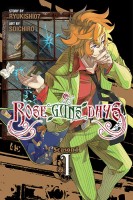This week, I’m catching up with Say I Love You, a shojo romance that’s been garnering strong reviews here and elsewhere since Kodansha began publishing it last August.
 Say I Love You, Vols. 1-3
Say I Love You, Vols. 1-3
By Kanae Hazuki
Rated OT, for older teens
Kodansha Comics, $10.99
Back in the 1980s, filmmaker John Hughes peddled an intoxicating fantasy to thirteen-year-old girls: you might be the class misfit–the kid who wore the “wrong” clothes, listened to the “wrong” music, and had the “wrong” friends–but the hottest guy in school could still fall for you. Better still, he’d like you for being a “real” person, unlike the two-faced girls who inhabited his social circle. You’d have a bumpy road to your happily-after-ever, of course, since his friends felt compelled to say that you weren’t in his league, but in the end, your sincerity and quirkiness would prevail.
Say I Love You reads a lot like a manga version of Pretty in Pink or Some Kind of Wonderful, right down to the meet-cute between Mei, a moody loner, and Yamato, the most popular guy in school. Mei mistakenly believes that Yamato tried to peek up her skirt, and responds with a powerful roundhouse kick. Though Yamato’s friends demand an apology from her, Yamato is intrigued by Mei’s display of bravado and asks her out.
Mei is initially bewildered by Yamato’s courtship: why would someone as outgoing, handsome, and well regarded find her interesting? (You, dear reader, may also wonder why Yamato pursues Mei, given her generally sullen demeanor.) As Mei soon discovers, however, Yamato’s dating history is more complicated than she assumed; his good looks belie an earnest, thoughtful person who lost his virginity before he met someone he really cared about. He’s willing to endure a few tearful outbursts–not to mention some mixed signals–if it means he’ll get to know the real Mei before they go all the way.
And speaking of mixed signals, Say I Love You is refreshingly honest in acknowledging the full spectrum of teenage desire. Some characters embrace their feelings in healthy ways; others use sex to fill a void in their emotional lives; and still others are just beginning to explore their sexuality. Though many of the sexual encounters in the series are ill-advised, the teenage logic that underpins them rings true; an adult may feel an uncomfortable pang of recognition while reading Say I Love You.
The series’ greatest strength, however, is that author Kanae Hazuki is unusually generous with her supporting players. We’re privy to both Mei and Yamato’s thoughts, of course, but Hazuki also pulls the curtain back on other characters’ interior lives. In volume two, for example, mean girl Aiko becomes the temporary focus of the story, narrating her own transformation from a plump, pretty girl to a skinny, angry young woman who is furious that Yamato doesn’t like her. Her blunt self-criticism and body hang-ups remind younger readers that everyone wears a mask in high school; even students who seem outwardly blessed with good looks or talent are wrestling with the familiar demons of self-doubt and self-loathing.
If I had any criticism of Say I Love You, it’s that the plot twists are a little too by-the-book, with beach visits, Valentine’s Day agita, and misunderstandings of the “I saw you kiss her!” variety. In volume three, for example, Hazuki introduces Megumi, a model who’s hell-bent on making Yamato her boyfriend. When a direct approach doesn’t work–Yamato, of course, rebuffs Meg’s initial proposition–Meg transfers schools and ropes Yamato into becoming a model himself. I realize that “model,” “celebrity,” or “singer” epitomize a thirteen-year-old’s dream job, but the artifice and obviousness of diving into the modeling world feels like an unnatural direction for such a finely observed romance.
Perhaps the best compliment I could pay Say I Love You is that it has all the virtues of Pretty in Pink and Some Kind of Wonderful: it’s got a proud, tough heroine who’s skeptical of the popular kids, a sincere hot guy who can see past her bluster, and a veritable Greek chorus of peers who chart the ups and downs of their relationship. All it needs is a killer soundtrack.
Reviews: At Brain vs. Book, Joceyln Allen sings the praises of Takehiko Moriizumi’s Mimi wa Wasurenai, an untranslated short story collection. “It’s okay if you don’t read Japanese,” she explains, “you can just stare at the beauty on every page. Moriizumi makes manga like nothing I’ve ever seen before.” Go see for yourself!
Saeyong Kim on vol. 1 of 21st Century Boys (No Flying No Tights)
Jessikah Chautin on Awkward (No Flying No Tights)
SKJAM on vols. 1-2 of Captain Ken (SKJAM! Reviews)
Kat Stark on vol. 1 of Devil Survivor (AiPT!)
Jessikah Chautin on vol. 1 of Durarara!! Yellow Scarves Arc (No Flying No Tights)
SKJAM on Gimmick! (SKJAM! Reviews)
Kat Stark on vol. 1 of Kiss Him, Not Me! (AiPT!)
Ian Wolf on vol. 1 of the Kurosagi Corpse Delivery Service Omnibus (Anime UK News)
David Brooke on vol. 1 of Ninja Slayer Kills (AiPT!)
Anna N. on vol. 2 of Requiem of the Rose King (The Manga Report)
Ian Wolf on vol. 2 of Requiem of the Rose King (Anime UK News)
Rebecca Silverman on vol. 1 of Rose Guns Days, Season One (Anime News Network)
Marissa Lieberman on vol. 1 of Seraph of the End (No Flying No Tights)
Sean Gaffney on vol. 11 of Umineko: When They Cry (A Case Suitable for Treatment)
Ash Brown on vol. 2 of Wayward: Ties That Bind (Experiments in Manga)
Ken H. on vol. 3 of Yamada-kun and the Seven Witches (Sequential Ink)






